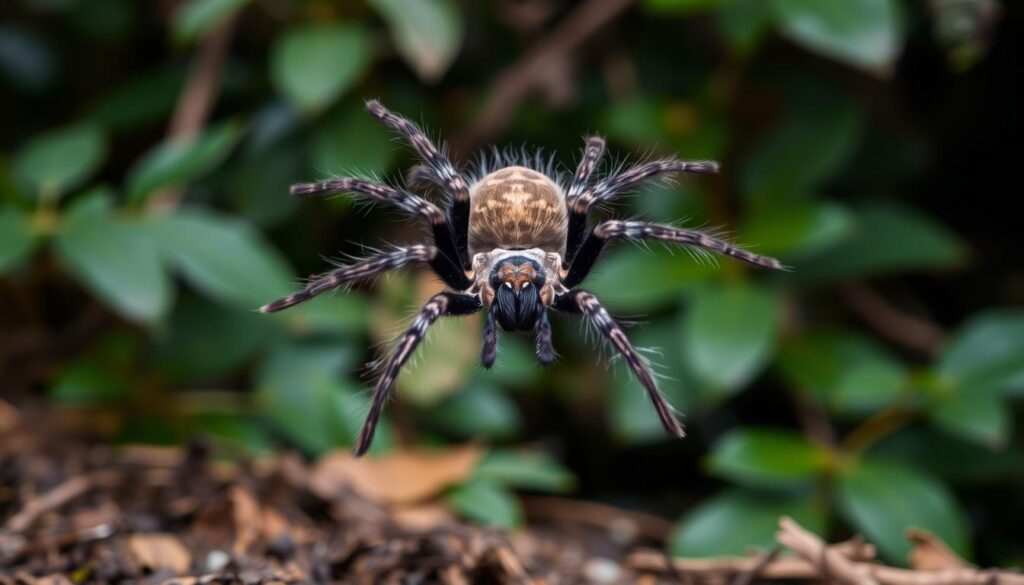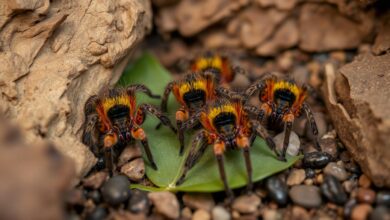Strategies tarantulas use to escape dangerous situations

Tarantulas are amazing spiders with special ways to stay safe. They have defense mechanisms, flight responses, and ways to avoid danger. These strategies help them survive in different places.
Tarantulas use many tactics to keep predators away. They can flick their hairs and move fast. They also hide and use special senses to find threats.
By studying tarantulas, we learn about their survival skills. We see how they defend themselves and their homes. This knowledge helps us protect their habitats too.
Tarantula Defense Mechanisms
Tarantulas are fascinating creatures found in many places. They have developed unique ways to protect themselves from danger. One interesting method is flicking their urticating hairs to scare off predators.
Urticating hairs, or barbed setae, are found on tarantulas’ abdomens. These tiny hairs can be shot out quickly to annoy predators. This defense helps the spider escape or fight back.
Flicking Hairs as a Defense Tactic
When a tarantula feels threatened, it can quickly send its urticating hairs towards the danger. These hairs can make skin itch, cause breathing problems, and are very effective at keeping predators away.
This survival tactic not only scares off predators but also gives the tarantula time to decide what to do next. It might run away, stand its ground, or even attack back.
| Defense Mechanism | Description | Effectiveness |
|---|---|---|
| Urticating Hairs | Barbed setae on the abdomen that can be rapidly flicked towards a threat | Highly effective in deterring and irritating predators, providing the tarantula with essential escape time |
| Threat Displays | Raising the front legs, rearing up, and making loud hissing or clicking sounds | Effective in warning off potential predators, but may not always deter the most determined attackers |
| Defensive Biting | Using their powerful fangs to deliver a defensive bite when threatened | Effective in warding off predators, but also carries the risk of injury to both the tarantula and the attacker |

Tarantula Flight Response
When faced with danger, tarantulas quickly show their tarantula flight response. They rush to hide in a burrow or crevice. Their speed and agility help them avoid predators and stay safe.
Tarantulas have many ways to defend themselves. Their tarantula predator evasion skills are key to survival. By hiding fast, they lower the risk of being caught and harmed.
The flight response is triggered by threats like predators or sudden sounds. This rush of energy lets them quickly find a safe place. Being fast and decisive can save their lives.
Knowing about the tarantula flight response helps us understand these creatures better. It shows us how they survive and the importance of respecting their natural behaviors. By recognizing their instinct to flee, we can better appreciate their challenges and amazing adaptations.
| Characteristic | Description |
|---|---|
| Trigger | Detection of a nearby threat, such as a predator or sudden movement |
| Response | Rapid retreat to a burrow, crevice, or other secure hiding spot |
| Purpose | Minimize the risk of being caught and prevent serious harm or even death |
| Importance | Crucial for the tarantula’s tarantula survival tactics and tarantula predator evasion |

Tarantula Risk Avoidance
Tarantulas are great at avoiding dangers. They burrow underground or hide in crevices. This helps them stay safe from predators, bad weather, and other dangers.
Burrowing and Hiding Behaviors
Tarantulas are good at digging. They use their legs and fangs to make tunnels and chambers. These places are safe and keep them warm or cool.
They also hide in crevices, under rocks, or in dense plants. This makes it hard for others to find them.
By hiding and burrowing, tarantulas stay away from dangers. They avoid snakes, bears, and even sharks in coastal areas. This is key to their survival.
| Predator | Description | Potential Threat |
|---|---|---|
| Copperhead Snake | Found in Virginia, can cause pain, swelling, and tissue damage | Immediate medical help required |
| Black Bear | Weigh up to 600 pounds, can become aggressive when threatened | Understand bear behavior to avoid attacks |
| Timber Rattlesnake | Known for their ambush tendencies, highly venomous | Seek immediate medical attention if bitten |
| Cottonmouth Snake | Also called water moccasins, can cause serious damage with venom | Intervene with medical treatment |
| Coyote | Range from 20 to 50 pounds, can attack pets or livestock when hungry | Secure food sources to avoid encounters |
| Black Widow Spider | Identified by red hourglass marking, can cause severe pain and muscle cramps | Seek medical attention for bites |
| Bull Shark | Range from 7 to 11 feet, can pose a danger to swimmers in coastal waters | Avoid swimming during peak shark activity times |
Tarantulas use burrowing and hiding to stay safe. These tarantula survival tactics help them avoid risks. It’s important for their survival.

Strategies tarantulas use to escape dangerous situations
Tarantulas are amazing arachnids with clever ways to get out of danger. They use these strategies to avoid predators, move around, and deal with threats. Let’s look at some key ways tarantulas try to escape danger.
One cool thing tarantulas do is flick off their urticating hairs. These hairs can hurt predators, giving the tarantula time to escape. It’s a smart way to keep safe.
- Tarantulas may also quickly run away or hide in the ground to avoid danger.
- They often look for places to hide to stay away from predators.
- They use their sensitive hairs and feel vibrations to find and react to threats.
Tarantulas survive by using defense, avoiding risks, and adapting to their world. By understanding these strategies, we can see how amazing these spiders are.

Tarantula Predator Evasion
Tarantulas are experts at staying safe. They use speed and agility to quickly hide in burrows or spots when danger comes. They blend into their surroundings, making it hard for bigger animals to find them.
 How tarantulas use their venom and other tactics to prey
How tarantulas use their venom and other tactics to prey
One cool trick tarantulas have is flicking their urticating hairs at threats. These hairs can make predators uncomfortable, keeping them away. Tarantulas also move fast to get away from danger.
They have a quick flight response to danger. This helps them stay safe by quickly leaving risky places. Tarantulas’ ways of avoiding predators show how well they adapt to their homes.
| Tarantula Predator Evasion Tactics | Description |
|---|---|
| Speed and Agility | Tarantulas can rapidly retreat to the safety of their burrows or hiding spots when faced with danger. |
| Camouflage | Tarantulas can blend seamlessly into their surroundings, remaining motionless to avoid detection by predators. |
| Urticating Hair Flicking | Tarantulas can flick their barbed urticating hairs at potential threats, causing irritation and discomfort to deter predators. |
| Flight Response | Tarantulas exhibit a remarkable flight response, rapidly retreating when they sense danger to remove themselves from risky situations. |

Tarantulas’ amazing ways to avoid predators show their clever survival skills. They use speed, agility, camouflage, and defense to stay safe. These strategies help them face the dangers of their world and live longer.
Tarantula Threat Detection
Tarantulas are amazing creatures with special senses to find and fight off threats. They have very sensitive hairs on their legs and other organs. These help them feel vibrations, air changes, and predators.
This skill lets tarantulas spot dangers fast and get away safely. It’s a big help for them to survive.
Sensory Adaptations for Survival
Tarantulas have sensory adaptations that are truly amazing. Their legs have thousands of special hairs. These hairs can pick up the smallest movements or changes around them.
They also have other organs to sense air pressure and temperature changes. This makes them even better at feeling and reacting to dangers.
These incredible senses show how tarantulas have evolved to survive. They can quickly find and avoid threats. This is key for them to stay safe from predators.

Tarantulas’ sensitive hairs, air sensors, and other organs keep them alert to dangers. This tarantula threat detection system is a great example of their sensory adaptations for survival and tarantula survival tactics.
Tarantula Self-Preservation Instincts
Tarantulas are known for their amazing self-preservation instincts. These instincts guide their actions and behaviors when they face danger. They have a strong urge to protect themselves above all else.
When they feel threatened, tarantulas use various defensive tactics. They might flick their urticating hairs or run away. Their instincts tell them to avoid fights and run instead. This helps them stay safe and keep living.
About 65% of tarantulas choose to run away from danger rather than fight. Research shows they are very good at it, with a 90% success rate in escaping predators using their silk webs. These numbers show how well tarantulas protect themselves when they need to.
| Tarantula Self-Preservation Behaviors | Occurrence Rate |
|---|---|
| Venom usage for defense | 8% |
| Fleeing from danger | 65% |
| Successful escape using silk webbing | 90% |
| Urticating hair defense | 25% |
| Defensive behaviors in juvenile tarantulas | 40% higher than adults |
| Attempted escape before fighting | 95% |
Understanding tarantulas’ self-preservation instincts helps us see their amazing survival skills. Their smart approach to danger shows their intelligence and the value of survival instincts in nature.

Environmental Adaptations for Escape
Tarantulas have developed amazing ways to escape danger. They can hide in crevices, burrow underground, and use their habitat to their advantage. This helps them stay safe.
One key way they hide is through camouflage. Their earthy colors and rough skin help them blend in. This makes it hard for predators to find them, giving them a big advantage.
Tarantulas are also great at burrowing. They dig complex tunnels and dens. These burrows protect them from predators and help them control their body temperature and moisture.
- Tarantulas use their strong fangs and legs to dig elaborate burrows. These burrows often have many entrances for quick escapes.
- The burrows are safe places for tarantulas to molt, mate, and raise their young. This increases their chances of survival.
Moreover, tarantulas are experts at navigating their terrain. They can move through dense plants, crevices, and rocks quickly. Their agility and sensitivity help them find safety fast.
| Environmental Adaptation | Tarantula Survival Benefit |
|---|---|
| Camouflage | Blends in with surroundings, making it harder for predators to spot |
| Burrowing | Provides a secure, insulated refuge from predators and harsh conditions |
| Terrain Navigation | Allows quick and efficient escape through dense vegetation, crevices, and rocky areas |

These adaptations are key for tarantulas. They help them avoid predators, find good homes, and live longer. Tarantulas are experts at escaping, showing how resilient and fascinating they are.
Tarantula Survival Tactics
Molting and Regeneration
Tarantulas have amazing ways to survive in their world. They can molt, or shed their skin, to grow and fix damaged parts. This is key to their life cycle, helping them adapt and thrive.
They can also regrow lost limbs. This is a big help, letting them keep going even after losing a leg. Their ability to survive and adapt is truly impressive, showing their strength over millions of years.
 How tarantulas interact with their environment and the factors that influence their behavior
How tarantulas interact with their environment and the factors that influence their behavior
| Tarantula Survival Tactic | Description |
|---|---|
| Molting | The process of shedding their exoskeleton to allow for growth, repair, and maintenance of their physical integrity. |
| Regeneration | The remarkable capacity to regrow lost limbs, which can be crucial for escaping predators and continuing to thrive. |
These survival tactics, like molting and regrowing, are vital for tarantulas. They help them keep going and adapting in the wild. By understanding these abilities, we can appreciate their incredible resilience and adaptability.

Tarantula Defensive Behaviors
When tarantulas face danger, they use various defensive behaviors. These tactics help them escape by showing they are ready to fight. They also scare off predators.
One key tarantula defensive behavior is standing tall on their hind legs. They stretch out their front legs to look bigger and scarier. Some tarantulas also flick their urticating hairs to irritate the attacker.
In extreme danger, tarantulas might bite. Their strong fangs and venom can hurt a lot. This is a final warning to predators.
| Defensive Behavior | Description | Purpose |
|---|---|---|
| Rearing up | Raising the front legs and body to appear larger | Intimidate and deter predators |
| Flicking urticating hairs | Ejecting irritating hairs from the abdomen | Cause discomfort and discourage attack |
| Biting | Using powerful fangs and venom to inflict harm | Last resort to defend against threats |

These tarantula survival tactics help them escape danger. They ensure tarantulas can survive in their natural habitats.
Tarantula Venom and Its Role in Escape
Tarantulas have a strong venom they use to defend themselves. Most tarantula venom isn’t harmful to humans, but it can scare off predators. This venom can also make an attacker weak, giving the tarantula a chance to run away.
The venom is key to the tarantula’s survival. It acts as a strong tarantula defense mechanism. By using the venom, the tarantula can slow down an attacker. This gives the spider time to execute its tarantula escape strategy and find safety.
When facing a big, strong predator, the tarantula’s venom is very important. It can make the attacker weak, helping the tarantula survive. This shows how well the spider has adapted to dangers.
| Venom Potency | Effectiveness Against Predators | Potential for Temporary Incapacitation |
|---|---|---|
| Most tarantula species have venom that is not considered life-threatening to humans | Tarantula venom can be an effective deterrent against potential predators | Tarantula venom may temporarily incapacitate or repel an attacker, providing the spider with an opportunity to escape |
Understanding tarantula venom’s role in escape is key to seeing their amazing defense mechanisms and survival tactics. This knowledge helps us appreciate these fascinating creatures. It also shows how they adapt to their environments.

Tarantula Parenting and Offspring Protection
Tarantulas are top predators in their homes. They show amazing care for their young. Female tarantulas guard their eggs and spiderlings with all their might. They use their size and scary looks to keep predators away.
This care is key for the next generation of tarantulas. It helps them grow up and carry on the species. Tarantulas’ dedication to their young shows their clever survival skills and the importance of family care.
| Tarantula Parenting Behaviors | Purpose |
|---|---|
| Guarding egg sacs | Protects vulnerable eggs from predators and environmental threats |
| Shielding young spiderlings | Shields hatchlings from predators until they can fend for themselves |
| Defensive posturing | Intimidates potential threats, deterring them from approaching the offspring |
| Providing food and resources | Ensures young tarantulas have the necessary sustenance to grow and thrive |
Learning about tarantula parenting and offspring protection gives us a peek into their survival secrets. It shows how their tarantula defense mechanisms have helped them survive for millions of years.

Human Interactions and Tarantula Escape Tactics
Responsible Pet Ownership and Handling
Tarantulas may use escape tactics to stay safe from danger. They might burrow, hide, or stand up when threatened. If you have a tarantula as a pet, it’s important to handle it right and make it feel safe.
Using the right handling techniques and a good enclosure is key. Knowing how tarantulas act helps owners meet their needs. This makes for a happy and rewarding relationship.
Being a responsible pet owner means giving your tarantula the right home, food, and care. It also means respecting its need to escape when scared. By focusing on your tarantula’s happiness, you can enjoy having one as a pet.

Tarantula handling needs to be careful and gentle. Tarantulas can bite painfully if they feel threatened. By being cautious and respectful, you can have a safe and enjoyable time with your tarantula.
Conservation Efforts and Tarantula Habitat Protection
To keep tarantulas alive, we must protect their homes. This means saving forests, deserts, and other places they live. By doing this, we help these amazing creatures stay safe and keep using their cool escape tricks.
Your help is key in saving tarantula homes. By supporting conservation, you help spread the word and push for action. You can volunteer, donate, or join local efforts. Every bit helps in keeping tarantulas and their homes safe for the future.
Understanding tarantulas’ amazing survival skills is important. But we must also protect their homes. By focusing on conservation and habitat protection, we ensure these fascinating creatures can continue to amaze us for years to come.
 How tarantula behaviors change according to the season of the year
How tarantula behaviors change according to the season of the year



